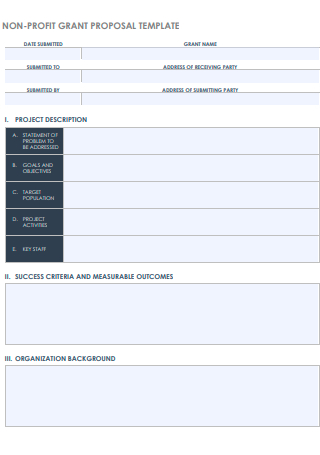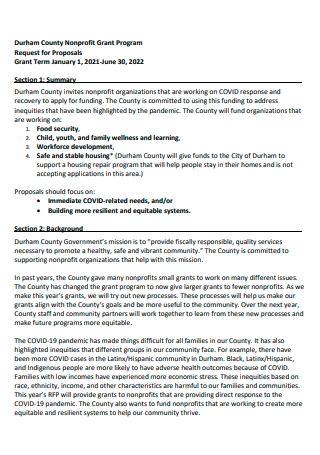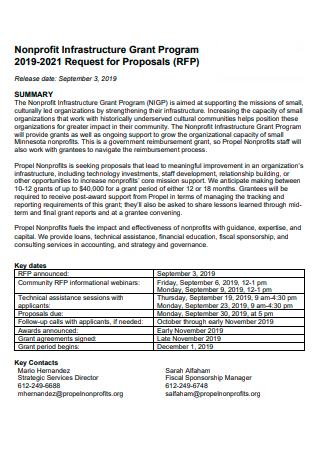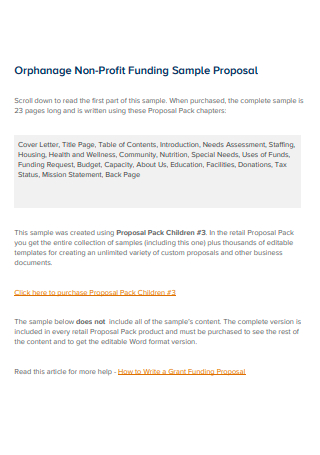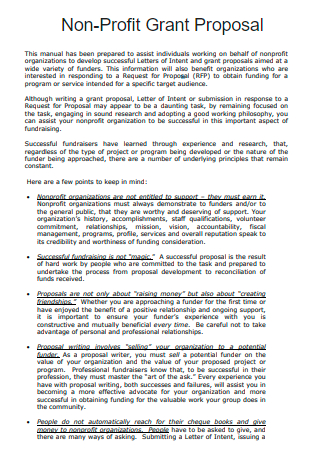5+ Sample Non-Profit Grant Proposal
FREE Non-Profit Grant Proposal s to Download
5+ Sample Non-Profit Grant Proposal
What Is a Non-Profit Grant Proposal?
Components of a Non-Profit Grant Proposal
How To Write a Non-Profit Grant Proposal
FAQs
How do you start a grant proposal?
How do you make a grant proposal stand out?
How long are grant proposal supposed to be?
What Is a Non-Profit Grant Proposal?
A nonprofit grant proposal is a document that a nonprofit organization creates that outlines what they plan to do with the grant money they are requesting. The nonprofit grant proposal calls to an institution to partner with them to accomplish a project or program. The document also expands on necessary information to appeal for money to the non-profit organization. Every year, there are plenty of corporations, firms, organizations, and government agencies that dispense generous amounts of funds for grants, providing many opportunities for nonprofits to grab the attention of these entities for their projects and programs. A nonprofit grant proposal must be persuasive and provide a well-supported argument to its audience to convince and approve of the project or program of the nonprofit organization. Implement successful grant writing strategies with a mixture of budget planning and strategic planning. Make sure that the grant proposal also communicates how the project or program the nonprofit plans to implement are in alignment with organizational goals and objectives.
According to an article from the Aspen Institute, a survey from The Bridgespan Group, and JPMorgan Chase, nonprofit organizations indicate the top four areas from communities that need the most help. Fundraising events rank first at 61 percent, followed by communications and marketing at 51 percent, program evaluation at 38 percent, and performance management at 31 percent.
Components of a Non-Profit Grant Proposal
It is challenging to win grants for a nonprofit organization, especially if grants come from government agencies, private foundations, and other grant-giving organizations that have limited funding capacities. There is no standardized format for creating nonprofit grant proposals, so it is vital for the team responsible for writing the document to become familiar with the essential parts of a non-profit grant proposal. The following section details the components of the grant proposal and descriptions to help better understand the document.
How To Write a Non-Profit Grant Proposal
With over thousands of nonprofit organizations across the world and the United States planning to apply for grants from different agencies, not every nonprofit will be lucky enough to have the grant. Many funding agencies can still cater to an NPO’s funding needs for a project if these organizations knew where to look. There are different ways for nonprofits to acquire a grant for their projects by writing an effective and comprehensive proposal. The section below details a helpful guide to writing a non-profit grant proposal for a funding agency.
-
1. Find the Best Grant Appropriate For the Project
If you do not know where to find a grant for your nonprofit budget, you can search for grant funds online, ask around from local foundations around your vicinity within similar fields, or go to a local library. The local library houses individuals that have experience and expertise in research studies that can help you in searching for the ideal funding agency. Remember not to waste so much time sending applications to agencies outside of the NPO’s niche. Instead, focus on those with similar interests and objectives.
-
2. Put Time and Effort into Conducting Research
Many funding institutions have requirements and guidelines when writing the non-profit grant proposal. If you already have a chosen institution to send the document to, familiarize yourself with the necessary guidelines and learn about the information about the submission process, including the submission date, financial limitations, and the letter of intent or LOI. After, visit the website of the financial institution and identify the previous NPOs who worked with them. Read about the critical feedback from these organizations to see if they are the best fit for the project.
-
3. Construct a Clear Grant Plan
The next step is to meet with team members and discuss work divisions and responsibilities. Since some grantors require NPOs to produce an LOI, which is a short version of a grant proposal, you must summarize the main goal and ideas you have for the project. The LOI provides a clear and brief insight of the organization, its plans, and the benefits of the donors from working with the nonprofit. Through the LOI, grantors can recognize whether the ideas or plans are a good fit for their agency.
-
4. Create the Letter of Intent
Make sure that the letter of intent is brief and eye-catching to the grantor. If the funding agency explicitly provides a format, the NPO must follow it. If there is no format available, the first paragraph of the LOI must indicate a summary of the grant request, explaining the offer, price, and reason for the project. It must also indicate the needs, program model, objectives, budget plan, project schedule, partners, organizational background, and contact information.
-
5. Write a Full Grant Proposal for the Organization
Upon the receipt and approval of the letter of intent, the next step is to prepare writing the entire grant proposal. Set up a consultation meeting with the project team and start composing the document. The non-profit grant proposal is a longer version of the grant proposal. Unlike academic papers, it does not require academic writing styles. The grant proposal must answer the essential questions regarding the project and how it benefits the funding agency. Make sure to include research data, statistics, necessary citations, and a reference list as necessary.
-
6. Meet the Given Deadline
Do not wait until the last submission date to pass the grant proposal. Many funding agencies are very strict when it comes to setting deadlines and will not hesitate to reject proposals past the assigned date. Give yourself enough time to revise and edit the document.
FAQs
How do you start a grant proposal?
The first step in writing any grant proposal is to write a cover letter or letter of intent to the funding organization.
How do you make a grant proposal stand out?
There are different ways to ensure that your organization’s grant proposal stands out. First, do sufficient research, find a good match for the nonprofit, make a good first impression, watch the language you use, paint a picture to tell a story, and follow the requirements from the funding agency.
How long are grant proposal supposed to be?
Depending on the requirements of a funding organization, grant proposals typically range from 5 to 25 pages.
Writing a grant proposal for a nonprofit organization is necessary to implement targeted projects to develop communities. The grant proposal helps explain how the programs can aid different neighborhoods while upholding the mission and vision of the nonprofit. It also ensures that the nonprofit share similar sentiments and goals for them to accomplish the project together. The grant proposal also provides valuable information about the nonprofit that can help the funding agency to make rational and fair decisions. Start writing a non-profit grant proposal for your organization by browsing and downloading from the 5+ SAMPLE Non-Profit Grant Proposal in PDF, only at Sample.net.

